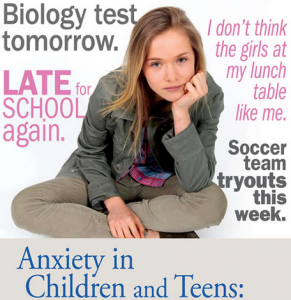We all have moments when we worry: “How am I going to get everything done?”; “What if I said the wrong thing?”; “Did I turn off the stove?” the list can go on and on. So how do we know when what you or a family member is experiencing is within the typical range of anxious behavior or when it has exceeded that? While there is no “one size fits all” answer to that question, there are a number of things to help you evaluate whether additional help is warranted. So how common is anxiety?
According to the National Institute of Mental Health:
There are currently 40,000 American adults (18 years of age or older) who suffer from some type of anxiety — roughly 18% of the population. A large national survey of adolescent mental health found that 8% of teens 13-18 have evidence of an anxiety disorder. It was also found that symptoms commonly started appearing at 6 years of age. The study also found that a mere 18% of these teens were getting help for their anxiety. Clearly anxiety touches many lives and starts earlier than many of us would have expected.
My favorite definition of anxiety is as follows: “Anxious thinking, generally speaking is characterized by an OVERESTIMATION or magnification of risk and an UNDERESTIMATION or minimization of coping ability. There’s nowhere to go you are boxed in.”
When things feel bigger than they actually, rationally, are and the perception is that you have no skills to deal with it, there is big gap in the center. That gap is where anxiety lives. Anxiety in and of itself is not necessarily a bad thing. Anxiety serves a purpose. It can be a source of protection making us analyze a situation more carefully or may even enhance our performance in a stressful situation. So how do you know when to take action? According to the website childanxiety (dot) net, the following are common fears that often go hand in hand with your child’s age and stage of development:
Infants/Toddlers:(ages 0-2 years) loud noises, strangers, separation from parents, large objects.
Pre-schoolers:(3-6 years) imaginary figures (ghosts, monsters) the dark, noises, sleeping alone, thunder floods)
School Aged Children/Adolescents:(7-16 years of age) physical injury, health school performance, death and natural disasters.
My rule of thumb for getting your child help so that they can better deal with their anxiety focuses on the intensity of their worries. If the degree of anxiety begins to affect your child’s functioning (i.e. sleep difficulties, somatic complaints, decrease in school attendance or performance, decrease in social interaction) and/or your entire family is being effected by your child’s level of anxiety (the behavior interferes with multiple facets of your daily life) it is time for help. The good news – there are effective therapeutic treatments that can help your child develop the coping skills they need to manage their anxiety. Children as young as preschool age can benefit. Don’t hesitate to seek help. You will all be the better for it!
October 01, 2012




